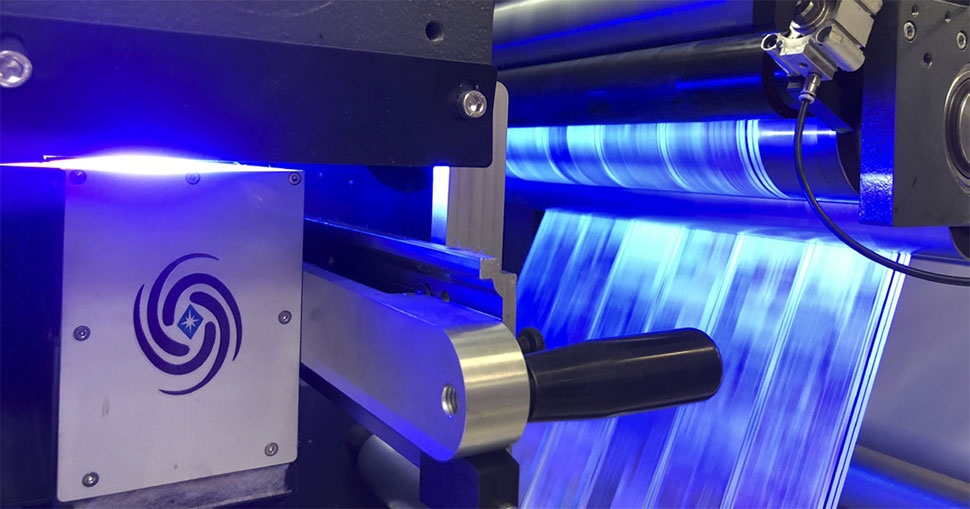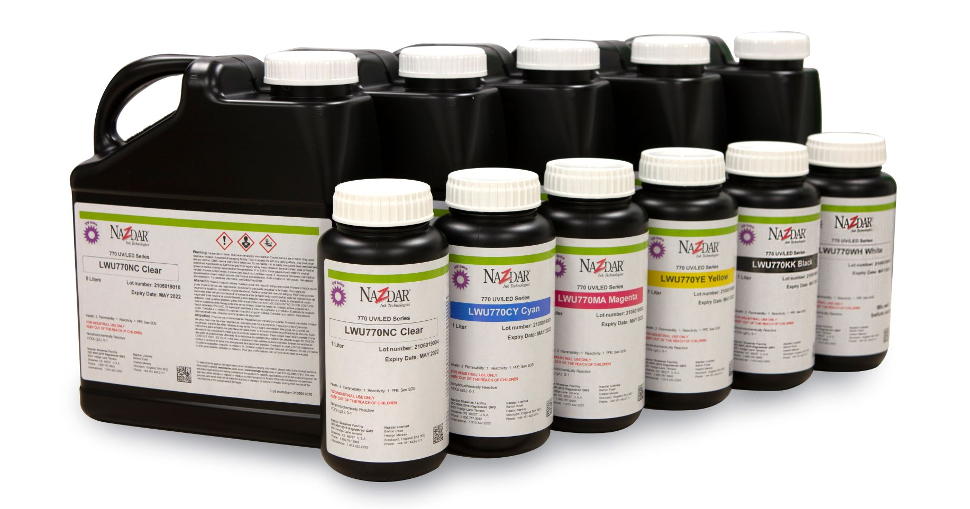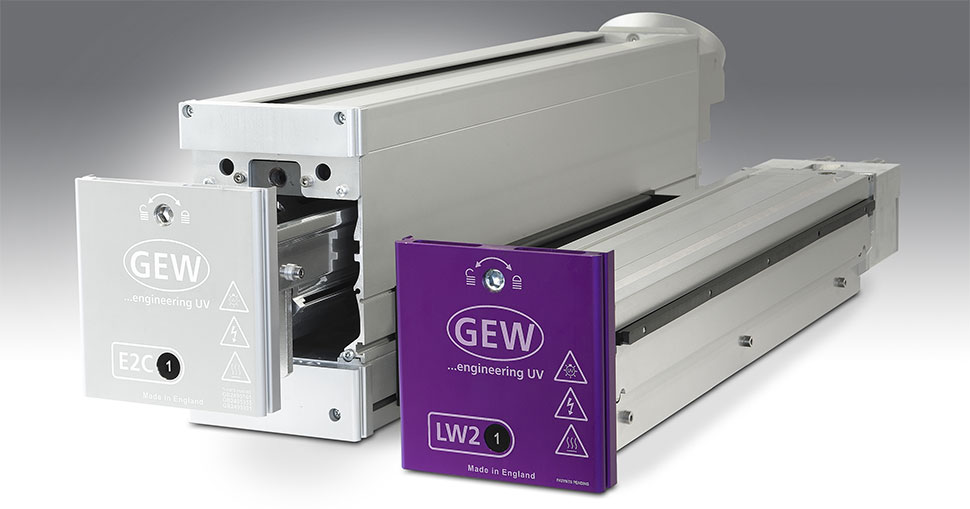Backed by almost 20 years of development, UV-LED inks and UV-LED curing systems are no longer a ‘bleeding edge’ technology, but instead now the weapons of choice for many printers across a range of markets.
Introduced in the early years of the 21st Century, UV-LED inks came to market with all kinds of promises to help make life easier for printers and allow them to achieve stunning output at lower costs than other more traditional inks.
Fast-forward 20 years to the current day and UV-LED inks are now being put to work on all sorts of print applications, delivering exactly what developers promised, with a few other benefits to boot!
Nazdar Ink Technologies was among the early adopters of this technology and has carefully developed its UV-LED inks products over the years to ensure they are meeting the ever-changing demand of print companies and their customers.
Such is the flexibility of UV-LED ink technology that products are available for use on digital inkjet machines, screen presses, narrow web printers and within flexo printing. Customers using any of these print technologies in combination with a properly integrated UV-LED curing system can be assured of a high level of output every time.
Over the years, the flexibility of UV-LED inks has continued to improve, to the point where these inks can not only be run on a range of printing presses, but also on a huge selection of substrates and at increasingly faster press speeds. In addition, UV-LED curing systems are now available with continuous length lamp head assemblies up to 1.7 meters long. As such, this opens their use to all sorts of print applications.
Nazdar’s commitment to maintaining this level of flexibility – and indeed the quality of its inks – means it continuously tests its products to ensure their durability, shelf-life, elongation and forming across all forms of printing technology.
Outside of Nazdar’s own specialist ink development facilities, some of the biggest names in print manufacturing have also embraced UV-LED, with the likes of Roland DG, EFI, Agfa, Mimaki, Ricoh, Epson and Canon all placing the technology among their key focus areas.
Meanwhile, the likes of Fujifilm, Coates, Polymeric and Sun Chemical now offer UV-LED products for digital inkjet, graphic screen and narrow web, while Flint Ink has products for digital inkjet and narrow web.
According to Jennifer Heathcote, Business Development Manager at GEW (EC) Limited, a supplier of UV curing systems for over 30 years: “In terms of equipment, GEW has made significant investments in its LED product portfolio and manufacturing capabilities.
“This has enabled us to satisfy increasing market demand to the point that we are now shipping almost one UV-LED lamp head for every two mercury vapor lamp heads.”
In addition, GEW always supplies complete LED UV curing solutions specifically designed for ease of integration onto printers. For those new to LED and not fully convinced of the technology’s capabilities, Arc/LED hybrid solutions, which consist of a cassette style lamphead and universal power supply, allow printers to quickly and easily swap between LED and mercury cassettes. This means printers can transition to LED at a pace that suits their need and comfort.
This level of commitment from the leading minds in print goes to show we can expect even more exciting and innovative announcements as work to improve these inks continues.
Josh Lutz, Market Segment Manager – UV Inkjet at Nazdar says, in a world of variables, one technology that has helped gain control of optimization was UV-LED pin curing: He explains: “This has created benefits in many ways such as control of dot gain, allowing visual effects of matte/gloss appearance, building structures or 3D effects, and altering Ink interactions to a degree.
“We see the use of pin curing in all UV inkjet processes and see great value in high-speed inline processes such as flexo/inkjet hybrid, direct-to-shape, product print and more. We are excited to see the continuous innovation of inkjet, mixed technologies, and the use of LED in general.”
Glenn Shull, Portfolio Manager, Graphic Inkjet Equipment and Ink at Nazdar, adds: “Heat has been barrier to widespread adoption of UV curing across the many platforms in the printing industry. LED-UV reduced a percentage of that heat, breaking through that barrier into most printing systems.
“Widespread adoption brought technology advancements that have made LED-UV the industry standard. It has it all: low energy consumption; lower heat; and speed for the continual improvements to printheads and ink.”
As demand continues to grow, Nazdar will work with all the top UV-LED OEM manufacturers to optimize print production performance for our customers.
Michael Beck, VP of Worldwide Sales at Phoseon Technology, says “Phoseon pioneered UV LED systems and works closely with companies like Nazdar to perfect the formulations and allow customers to realize the huge advantages of a high-performance UV LED system.” UV LED inks offer many benefits to the process when coupled with the properly engineered LED lamps.

“For flexo printing, stronger and deeper colors can be realized due to the ability of LED to penetrate heavier ink deposits,” he said. “Opaque whites are more opaque, metallic colors offer improved brilliance and you can now run fluorescent colors without fear of color shift on press from the UV light. The low heat load of a UV LED system also enables heat sensitive film applications including shrink sleeves.”
So where does this place UV-LED inks now and what else can we expect from the market? Since becoming more mainstream, the pricing for both the equipment and inks has become much more affordable, which in turn makes return on investment much easier to recoup for users.
Jennifer Heathcote continues: “GEW is leveraging recent technical innovations and economies of scale to supply many UV-LED curing systems at capital costs that are often less than equivalent mercury vapor systems. When combined with a lower cost of operation and increased productivity, it is easy to see why UV-LED curing has become the preferred choice for many in the printing industry”.
There are also the many environmental benefits of using UV-LED, in that this technology uses a lot less energy than other printing methods and the inks are free of solvents, meaning they don’t release any VOCs, making them much more friendly to the planet.
Michael Beck concurs that technology in this market is driving change, saying UV LED is dominant in several printing and industrial curing markets. UV LED is expected to surpass mercury in all segments by 2025, offering a much greener solution to printers and their customers.
“Sustainability is a key initiative for major global brands and their sustainability efforts will influence the business for the converters that produce for them,” he said. “Mercury is toxic and bulb disposal creates a waste stream. LED curing systems typically do the same work or more while using less than one-half of the energy. We believe that the only sustainable UV curing option is LED.”
Aside from the clear environmental benefits, Michael Beck says there are many more advantages with UV-LED including cost and performance benefits. “The lifetime cost of LED curing is significantly less than mercury which requires regular replacement of bulbs, filters and reflectors. Eliminating consumable replacements by using LED results in higher press utilization, more substrate utilization and improved production yield. The bottom line is more profit for the converter.” He qualified this by adding, “The value propositions above are highly dependent on a reliable, stable, and long-life UV LED lamp design. The popularity of UV LED has attracted many followers so choose wisely.”
Printers using UV-LED inks can communicate these benefits to their own customers, and in a world where the environment is now a critical consideration when it comes to any sort of work, this could be the difference between printers winning new contracts or indeed seeing them awarded to their greener-minded rivals.
Michael Beck concludes: “The printing industry has adopted LED curing across many market segments. Digital inkjet printing was the first segment to incorporate LED and Nazdar was one of the early adopters. Screen, offset, and flexographic presses have been incorporating LED for years and that pace is increasing as the portfolio of LED inks, coatings, and adhesives continues to quickly grow.”
High quality, reliable, cost-effective and environmentally friendly; UV-LED inks are now the new normal for printers succeeding in all sorts of markets.
For more information on Nazdar and its comprehensive range of ink solutions, please click here






